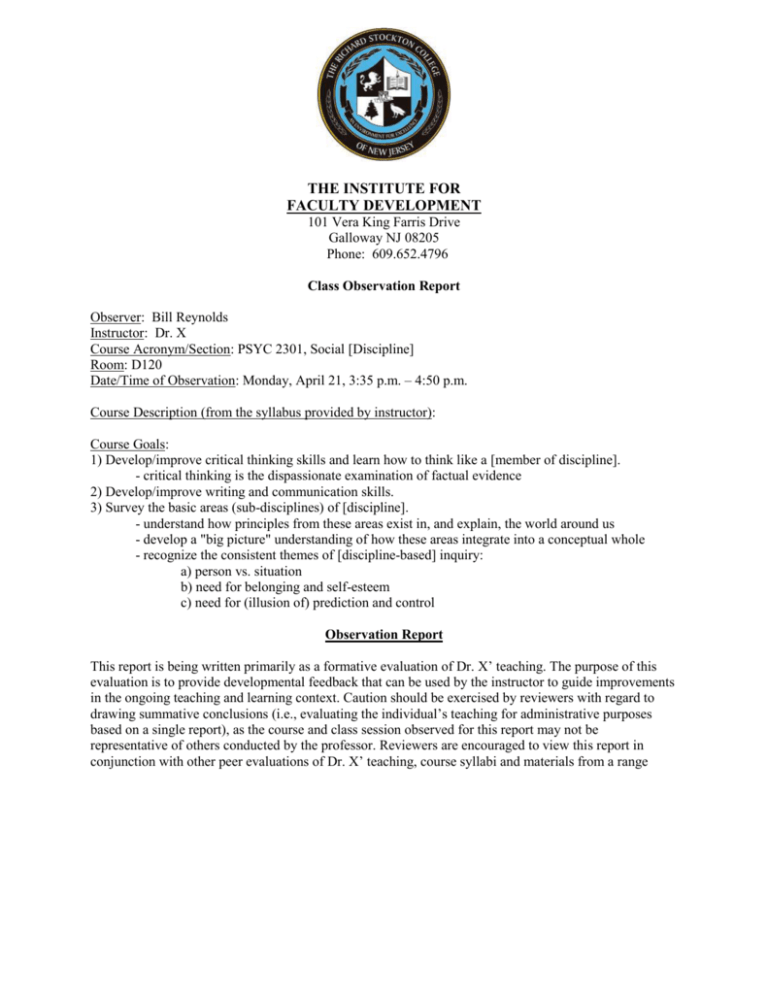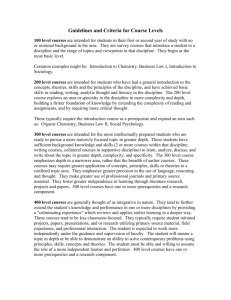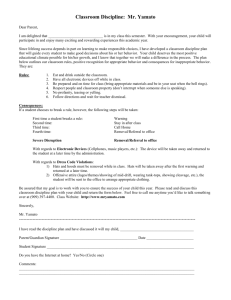Class Observation Report - Richard Stockton College of New Jersey
advertisement

THE INSTITUTE FOR FACULTY DEVELOPMENT 101 Vera King Farris Drive Galloway NJ 08205 Phone: 609.652.4796 Class Observation Report Observer: Bill Reynolds Instructor: Dr. X Course Acronym/Section: PSYC 2301, Social [Discipline] Room: D120 Date/Time of Observation: Monday, April 21, 3:35 p.m. – 4:50 p.m. Course Description (from the syllabus provided by instructor): Course Goals: 1) Develop/improve critical thinking skills and learn how to think like a [member of discipline]. - critical thinking is the dispassionate examination of factual evidence 2) Develop/improve writing and communication skills. 3) Survey the basic areas (sub-disciplines) of [discipline]. - understand how principles from these areas exist in, and explain, the world around us - develop a "big picture" understanding of how these areas integrate into a conceptual whole - recognize the consistent themes of [discipline-based] inquiry: a) person vs. situation b) need for belonging and self-esteem c) need for (illusion of) prediction and control Observation Report This report is being written primarily as a formative evaluation of Dr. X’ teaching. The purpose of this evaluation is to provide developmental feedback that can be used by the instructor to guide improvements in the ongoing teaching and learning context. Caution should be exercised by reviewers with regard to drawing summative conclusions (i.e., evaluating the individual’s teaching for administrative purposes based on a single report), as the course and class session observed for this report may not be representative of others conducted by the professor. Reviewers are encouraged to view this report in conjunction with other peer evaluations of Dr. X’ teaching, course syllabi and materials from a range of courses, and IDEA scores in multiple classes over the course of several semesters to form a holistic impression of the quality of his teaching. Professor X is an Assistant Professor of [Discipline]. The course I observed, [Course Z], is an elective course in [Discipline] program. The class meets on MW from 3:35 p.m. – 5:25 p.m. Prior to my observation Dr. X and I met to discuss the class I would observe, his approach to teaching, and aspects of his teaching methods and style about which he would like feedback. He noted that his main goals for every class are: to establish a good rapport with students; to engage them in independent and critical thinking; and to support the integration of course material that moves students beyond just learning facts. Before the day of the observation Dr. X provided me with a copy of his syllabus and handouts related to the content of the session I would observe. On the day of the observation 24 students were present by the 3:35 start time, and a couple of others arrived within the first five minutes. Content The topic of this session was gender, and in preparation for class students were to have read one article and a chapter on gender in their text. Dr. X typically gives a weekly quiz as a check of students’ understanding of the reading, but he chose not to give one on the day of my observation so the class would have more time to discuss content. Dr. X’ first instruction to the students was to tell him something about the assigned article. The first students to respond indicated that they found the article difficult and unclear, so Dr. X began asking more focused questions to help guide the class to important pieces of information about the article. For example, he asked them for the independent variable, dependent variable, and for definitions of relevant terms such as heteronormativity, androcentric, and gynocentric. In response to each question multiple students raised their hands, and Dr. X often asked follow up questions to elicit additional information. He put the key details from the study on the whiteboard as the students provided them, and most students took notes throughout the discussion. After details of the study were outlined on the whiteboard, Dr. X began to ask questions requiring students to apply information about the study. For example, he asked them about the implications of the study findings and what about the results represented new information. Dr. X also pointed students toward theories they had learned earlier in the semester that would help explain the results they were discussing. This discussion of the study expanded naturally to include themes from the textbook chapter on gender that provided additional content for the session. For the remainder of the time I was present (I had to leave the session approximately 15 minutes before it ended) Dr. X continued to ask students questions that helped them understand additional concepts and theories related to the role of gender in [Discipline], including [A], [B], [C], [D], [E], [F] and others. Method and style Although this course is categorized as “Lecture Instructional Method” in the online Course Listing, Dr. X described his approach to the course as a seminar in which he attempts during every session to engage as many students as possible in a discussion intended to help them think critically about the key concepts and theories of social [Discipline]. The session that I observed matched this description. Dr. X began his interaction with the class by asking a question (What can you tell me about…?), and he maintained this approach throughout the period. Rather than offering an extended discourse on the topic at hand, Dr. X’s approach was to use answers and other comments provided by students to create linkages to concepts and theories they had previously studied so that the topic of gender was contextualized within the conceptual framework of the [Discipline]. Dr. X’ teaching style was primarily that of a facilitator. While he spoke authoritatively on gender (his course bibliography indicates he has published on the topic), he was less interested in conveying what he knows about the topic than he was in guiding the students toward the construction of their own points of view and perspectives on the topic. Thus, his style was also primarily learner-centered, with an emphasis on using questions to help students develop a better understanding of the topic under consideration. Evaluation: Meeting of Standards of Excellence in Teaching Below is a list of the [Discipline] Program Standards Aligned with College Standards that are relevant to this observation. In my opinion, Dr. X’ teaching during the class I observed met the College and Program standards for excellence that appear in bold-faced type. Where appropriate, I also elaborate in a bulleted statement after the standard about the teaching behaviors I observed. 6.1.2.1 A thorough and current command of the subject matter, teaching techniques and methodologies of the disciplines one teaches. Dr. X demonstrated a deep understanding and easy command of the subject matter. In his responses to student questions he made connections among relevant [disciplinary] theories, and he provided illustrative examples that demonstrated his detailed knowledge of the evidence base for the topic under discussion. His seminar approach was an appropriate method for achieving the objectives he has established for this course. 6.1.2.2 Sound course design and delivery in all teaching assignments- whether program or General Studies, introductory or advanced offerings- as evident in clear learning goals and expectations, content reflecting the best available scholarship or artistic practices, and teaching techniques aimed at student learning. It is difficult to evaluate this standard on the basis of one classroom observation. However, it appears that Dr. X is immersed in the scholarship on the role of gender in [Discipline], the topic of the lesson I observed, and his approach to facilitating a student-focused discussion of the subject was appropriate to his course objectives. It was apparent that students were familiar and comfortable with Dr. X’ expectations for their participation during this class. However, he did not explicitly state his learning goals for the session, so some students may have felt uncertain about whether they had covered the relevant material and were meeting Dr. X’s expectations. 6.1.2.3 The ability to organize course material and to communicate this information effectively. The development of a comprehensive syllabus for each course taught, including expectations, grading and attendance policies, and the timely provision of copies to students. Dr. X gave me the handouts students received containing content related to the day’s lesson. These materials clearly conveyed definitions of key terms, brief explanations of relevant theories, and a list of “supposed gender differences. These served as an effective guide through the day’s content. Many syllabi I have reviewed contain a tremendous amount of information students are unlikely to retain or, in some cases, I’m sure, even read. Therefore, I commend Dr. X for constructing a syllabus that is brief, clear, and absent extraneous information. However, he might consider including a bit more information such as a brief statement of procedures for students requiring accommodations; a description of the requirements for “review papers,” which are worth 25 percent of students’ grade; and concrete behavioral expectations for classroom comportment, attendance, etc. It may be that Dr. X provides this information verbally or electronically (e.g., via Blackboard), and if so, he perhaps could indicate on the syllabus where the information can be found. o NOTE: During our post-observation follow-up session, Dr. X indicated that in order to keep his syllabus focused he provides information about papers and classroom behavioral expectations separately. 6.1.2.4 Excellence in teaching also entails respect for students as members of the Stockton academic community, the effective response to student questions, and the timely evaluation of and feedback to students. Before class even began, Dr. X engaged in a dialogue with a student in response to her questions and observations. Although he may have needed this time to organize his materials for the class, he was patient and encouraging in his responses, and my impression was that the student felt heard and appreciated. As a learner-centered instructor, my impression from one observation is that Dr. X demonstrates his respect for students by establishing high, but reasonable, expectations for them, and he treats their questions seriously, providing thoughtful answers to them. I did not observe Dr. X evaluating students. 6.1.3.1 Ability to use technology in teaching. Not observed. 6.1.3.2 The capacity to relate the subject matter to other fields of knowledge. When providing illustrative examples of theories and concepts during this session, Dr. X often made connections between the subject matter of the days lesson and other fields of knowledge such as climate science and biology. 6.1.4 In [Discipline], we also value teaching that engages students in addressing professional, community and social issues and needs. Dr. X encouraged students to apply concepts from the lesson to their own personal and professional experiences to increase their understanding. In discussing myths about gender differences, Dr. X helped students see how the theories and principles of [Discipline] can be useful in addressing gender inequality and other social needs. Evaluation Summary I found Dr. X to be a dynamic and effective instructor who was highly knowledgeable about his subject matter. He was skilled at asking questions that inspired students to think more deeply about the topic at hand, and he helped them make connections between the day’s lesson on gender and theories and concepts they had learned previously. He was relaxed, comfortable, and confident in his presentation of self, yet he maintained a clear focus on the material at hand, guiding the discussion back to the day’s topic when it started to go too far off track. He provided clear answers to students’ questions, and his interactions with them suggest that he genuinely respects and likes them. One purpose of the process of peer observation of teaching is to provide those being observed with constructive feedback to aid in their professional development. To that end, I make the following observations and suggestions that I hope Dr. X will find of value. Students might find it helpful if Dr. X provides them with the learning outcomes he would like to accomplish during the session as well as indicators of how they will know those outcomes have been achieved. During my observation I had the impression that Dr. X knew what he wanted to achieve, but greater transparency with his students about those objectives will help them to be more informed participants and to better evaluate if they are meeting expectations. One of the expectations of students in a seminar-style class is that they all (or at least most) will be actively involved in the discussion and engaged with the subject matter. This level of interaction can be difficult to achieve in a class of 25+, and Dr. X’s inclination was to call on students who volunteered answers, which meant that a significant proportion of students did not speak. While this doesn’t necessarily mean that the silent students were not engaged and following the discussion, it is difficult to evaluate the extent to which they were or were not. Therefore, Dr. X might consider strategies for increasing the level of student engagement and/or increasing his opportunities for evaluating the level of engagement. A couple of these are: o Pose critical thinking questions related to the day’s content and have students answer them in small groups before reporting back to the full class. o After a student provides an answer or asks a question in the full group discussion, instead of answering or moving on, call on another student to respond, reframe, or answer the first student’s point. o Start the session by having students write for 5 minutes in response to a prompt related to the day’s content, which encourages engagement with the topic from all students. Pause a couple of more times throughout the period when the topic is shifting to do the same, so that any student who is called on has something prepared. I thank Dr. X for inviting me to observe his class and for sharing his course materials with me. Based on my observation of his class, I believe Dr. X is a dynamic and effective instructor who respects his students and cares that they achieve success in his class. In my opinion he achieved his goals of establishing a good rapport with students; engaging them in independent and critical thinking; and supporting the integration of course material that moves students beyond just learning facts. Bill Reynolds, PhD, LCSW Associate Professor of Social Work Director, Institute for Faculty Development





